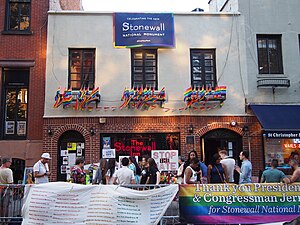
Back Stonewall Inn Afrikaans Stonewall Inn AST Stonewall Inn Catalan Stonewall Inn Danish Stonewall Inn German Stonewall Inn Esperanto Stonewall Inn Spanish Stonewalli trahter Estonian Stonewall Inn Basque بار استونوال Persian
Stonewall Inn | |
New York City Landmark No. 2574
| |
 Facade of Stonewall Inn during the 2016 Pride celebrations | |
 | |
| Location | 53 Christopher Street, Greenwich Village, Manhattan, New York City |
|---|---|
| Coordinates | 40°44′02″N 74°00′08″W / 40.73389°N 74.00222°W |
| Part of | Greenwich Village Historic District[1] (ID79001604) |
| NRHP reference No. | 99000562 |
| NYSRHP No. | 06101.004950[1] |
| NYCL No. | 2574 |
| Significant dates | |
| Added to NRHP | June 28, 1999[3] |
| Designated NHL | February 16, 2000[4][5][6] |
| Designated NMON | June 24, 2016[7] |
| Designated CP | June 19, 1979[1] |
| Designated NYSRHP | March 24, 1999[1] |
| Designated NYCL | June 23, 2015[2] |
The Stonewall Inn (also known as Stonewall) is a gay bar and recreational tavern at 53 Christopher Street in the Greenwich Village neighborhood of Manhattan in New York City. It was the site of the 1969 Stonewall riots, which led to the gay liberation movement and the modern fight for LGBT rights in the United States. When the riots occurred, Stonewall was one of the relatively few gay bars in New York City. The original gay bar occupied two structures at 51–53 Christopher Street, which were built as horse stables in the 1840s.
The original Stonewall Inn was founded in 1930 as a speakeasy on Seventh Avenue South. It relocated in 1934 to Christopher Street, where it operated as a restaurant until 1966. Four mafiosos associated with the Genovese crime family bought the restaurant and reopened it as a gay bar in early 1967. The Stonewall Inn was a popular hangout for gay men, particularly for youth and those on the fringes of the gay community. Stonewall operated as a private club because it was not allowed to obtain a liquor license; police raided the bar frequently, in spite of bribes from the owners. The Stonewall riots of June 28 to July 3, 1969, took place following one such raid.
The bar went out of business shortly after the riots, and the two buildings were divided and leased to various businesses over the years. In 1990, Jimmy Pisano opened a new bar at 53 Christopher Street, which was initially named New Jimmy's before becoming Stonewall. After Pisano's death in 1994, his boyfriend Thomas Garguilo took over the bar, followed by Dominic DeSimone and Bob Gurecki. The Stonewall Inn closed in 2006, and it reopened in March 2007 after Bill Morgan, Tony DeCicco, Kurt Kelly, and Stacy Lentz acquired the bar. The structure at 51 Christopher Street became a visitor center for the Stonewall National Monument in the 2020s.
The buildings themselves are architecturally undistinguished, with facades of brick and stucco, while the original bar's interior has been modified significantly over the years. The modern bar hosts various events and performances, and its owners also operate an LGBT advocacy organization. The Stonewall Inn became a tourist attraction and a symbol of the LGBT community after the riots, and various works of media about the bar have been created over the years. In part because of its impact on LGBT culture, the Stonewall Inn is the first LGBT cultural site designated as a National Historic Landmark and a New York City designated landmark. The bar is also part of the Stonewall National Monument, the first U.S. National Monument dedicated to the LGBT rights movement.
- ^ a b c d "Cultural Resource Information System (CRIS)". New York State Office of Parks, Recreation and Historic Preservation. November 7, 2014. Archived from the original on April 4, 2019. Retrieved July 20, 2023.
- ^ Landmarks Preservation Commission 2015, p. 1.
- ^ National Park Service (2008). "Workforce Diversity: The Stonewall Inn, National Historic Landmark National Register Number: 99000562". US Department of Interior. Archived from the original on March 6, 2016. Retrieved December 30, 2008.
- ^ National Historic Landmarks Program (2008). "Stonewall". National Park Service. Archived from the original on February 21, 2009. Retrieved December 30, 2008.
- ^ Carter, David; Dolkart, Andrew Scott; Harris, Gale; Shockley, Jay (May 27, 1999). "National Historic Landmark Nomination: Stonewall (Text)" (PDF). National Park Service. Archived (PDF) from the original on June 26, 2021. Retrieved June 5, 2021.
- ^ David Carter; Andrew Scott Dolkart; Gale Harris & Jay Shockley (May 27, 1999). "National Historic Landmark Nomination: Stonewall (Photos)". National Park Service. Archived from the original on February 24, 2024. Retrieved December 30, 2008.
- ^ Cite error: The named reference
Wheaton 2016 c901was invoked but never defined (see the help page).